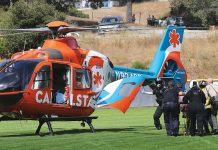WATSONVILLE — After experiencing seven traffic fatalities over the past few years in the city, Watsonville has a new vision: to eliminate all fatalities and severe injuries on city streets by 2030.
The Watsonville City Council on Tuesday adopted Vision Zero, an initiative first implemented in Sweden in the 1990s that acknowledges that traffic fatalities are preventable while coming up with solutions to achieve a zero death goal. San Jose, San Francisco, Los Angeles and other cities have also adopted Vision Zero, and Watsonville is the first in Santa Cruz County to do so.
Watsonville Principal Engineer Murray Fontes said more than 40,000 people are killed on American streets annually.
“We’ve become desensitized because of their frequency,” he said. “Traffic deaths should not be considered an inevitable side effect of modern life.”
By adopting the initiative, representatives of various city departments, public agencies and community members will now develop a plan and bring it to the council within a year. The plan, which will gather data on traffic issues, will also include what is called the “six E’s”: encouragement, education, enforcement, evaluation, engineering and equity.
According to a report by the Community Traffic Safety Coalition, using data compiled from the California Office of Traffic Safety, Watsonville ranks the worst out of 105 cities in the state of similar size for injuries and fatalities among pedestrians under the age of 15.
About 30 percent of all fatal and injury crashes occur on the same 2.3 miles of city streets, mostly centered around Main Street, Airport Boulevard, East Lake Avenue and Riverside Drive.
Watsonville is already undergoing projects that complement Vision Zero, according to Fontes, thanks to a $2.3 million grant it recently received from the Santa Cruz County Regional Transportation Commission. Later this year, a section of Airport Boulevard from Westgate Drive to Hangar Way will receive new sidewalks as well as flashing beacons at pedestrian crosswalks.
Green bike lanes will also be installed at various locations within the city.
Councilman Oscar Rios said education is a key component of the plan. Many people in the city wear dark clothing while walking at night, he noted, which makes them difficult to see for drivers.
“If I wear all dark clothes while crossing the street, I’m taking a chance, compared to if I wear a bright shirt,” Rios said.
Councilwoman Nancy Bilicich also emphasized the need for traffic and pedestrian safety education.
“Just because you are in the crosswalk, doesn’t mean you are safe,” she said.
Theresa Rogerson of the Community Traffic Safety Coalition said the plan is to gather more data that includes stories about how people have been affected by traffic collisions.
“The people we lose in these traffic collisions are our brothers and sisters, our grandparents, our children, our coworkers,” she said.
The plan to be presented in a year will include ways to increase traffic safety through infrastructure improvements for all road users.












